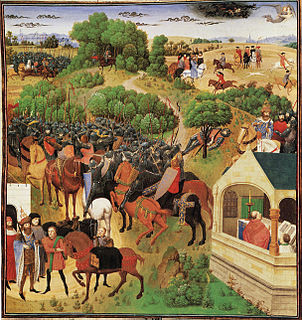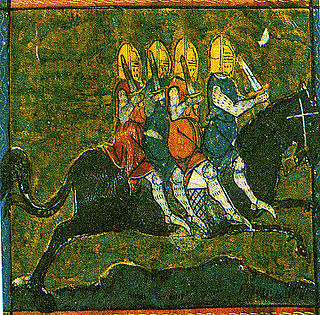
The chanson de geste is a medieval narrative, a type of epic poem that appears at the dawn of French literature. The earliest known poems of this genre date from the late eleventh and early twelfth centuries, before the emergence of the lyric poetry of the trouvères (troubadours) and the earliest verse romances. They reached their highest point of acceptance in the period 1150–1250.
Doon de Mayence was a fictional hero of the Old French chansons de geste, who gives his name to the third cycle of the Charlemagne romances dealing with the feudal revolts.

Bayard is a magic bay horse in the legends derived from the chansons de geste. He is renowned for his spirit, and possesses the supernatural ability to adjust his size to his riders.

Renaud de Montauban was a fictional hero and knight who was introduced to literature in a 12th-century Old French chanson de geste known as Les Quatre Fils Aymon. The four sons of Duke Aymon are Renaud, Richard, Alard, and Guiscard, and their cousin is the magician Maugris. Renaud possesses the magical horse Bayard and the sword Froberge.

Valentine and Orson is a romance which has been attached to the Carolingian cycle.

Fierabras or Ferumbras is a fictional Saracen knight appearing in several chansons de geste and other material relating to the Matter of France. He is the son of Balan, king of Spain, and is frequently shown in conflict with Roland and the Twelve Peers, especially Oliver, whose prowess he almost rivals. Fierabras eventually converts to Christianity and fights for Charlemagne.

Ferragut was a character—a Saracen paladin, sometimes depicted as a giant—in texts dealing with the Matter of France, including the Historia Caroli Magni, and Italian romantic epics, such as Orlando innamorato by Matteo Maria Boiardo and Orlando furioso by Ludovico Ariosto. In the tales, he was portrayed as physically invulnerable except at his navel/stomach, and was eventually killed by the paladin Roland.
Historia Caroli Magni, also known as or Historia Karoli Magni et Rotholandi and sometimes as the Turpin Chronicle or the Pseudo-Turpin Chronicle, is a 12th-century Latin forged chronicle of legendary material about Charlemagne's alleged conquest of Spain. It is also called Book IV – The Conquests of Charlemagne of the Codex Calixtinus. The chronicle states it was written by Charlemagne's contemporary Turpin, Archbishop of Reims, but it was found out as a medieval forgery. The work was extremely popular, and served as a major source of material on Charlemagne in chronicles, fiction and iconography throughout Medieval Europe. The miracles of the flowering lances and the death of Ferracutus appear on the windows of Chartres cathedral.
Duke Aymon of Dordone is a character in the Old French Matter of France, appearing in chansons de geste and Italian romance epics depicting the adventures of Charlemagne and his knights. The son of Doon de Mayence, he is the Duke of Dordone and the father of four sons, Renaud, Guichard, Alard and Richard, who are the heroes of Les Quatre Fils Aymon or The Four Sons of Aymon.
Flamberge is a fictional medieval sword. Swung by a number of heroes of chansons de geste and romances, the name became a generic name for a large sword.
Andrea Mangiabotti, called Andrea da Barberino was an Italian writer and cantastorie ("storyteller") of the Quattrocento Renaissance. He was born in Barberino Val d'Elsa, near Florence and lived in Florence. He is principally known for his prose romance epic Il Guerrin Meschino, his I Reali di Francia, a prose compilation of the Matter of France epic material concerning Charlemagne and Roland (Orlandino) from various legends and chansons de geste, and for his Aspramonte, a reworking of the chanson de geste Aspremont, which also features the hero Ruggiero. Many of his writings probably derive from Franco-Italian works, such as the Geste Francor, that includes versions of the stories of Reali di Francia and dates to the first half of the fourteenth century. His works, which circulated at first in manuscript, were extremely successful and popular, and were a key source of material for later Italian romance writers, such as Luigi Pulci (Morgante), Matteo Maria Boiardo and Ludovico Ariosto.
Agolant or Agolante is a fictional character in Medieval and Renaissance romantic epics dealing with the Matter of France, including Orlando innamorato by Matteo Maria Boiardo and Orlando furioso by Ludovico Ariosto. He is a Saracen king from Africa.
Chanson d'Aspremont is a 12th-century Old French chanson de geste. The poem comprises 11, 376 verses, grouped into rhymed laisses. The verses are decasyllables mixed with alexandrines.

Veillantif (French), Vielantiu ; Vegliantin, Vegliantino or Brigliadoro (Italian) is the name of Roland the paladin's trustworthy and swift steed in the stories derived from the chansons de geste. The French name comes from an expression meaning "vigilant". Veillantif is first mentioned in The Song of Roland.
Girart de Vienne is a late twelfth-century (c.1180) Old French chanson de geste by Bertrand de Bar-sur-Aube. The work tells the story of the sons of Garin de Monglane and their battles with the Emperor Charlemagne, and it establishes the friendship of the epic heroes Olivier and Roland.
The Chanson de Guillaume, also called Chançun de Willame, is a chanson de geste from the first half of the twelfth-century. The work is generally considered to have two distinct halves: the first tells of Guillaume of Orange, his nephew Vivien and the latter's young brother Gui and their various battles with Saracens at L'Archamp; in the second half of the poem, Guillaume is aided by Rainouard, a giant.
The Charroi de Nîmes, is an Old French chanson de geste from the first half of the twelfth-century, part of the cycle of chansons concerning Guillaume of Orange, generally referred to collectively as the Geste de Guillaume d'Orange.

The Four Sons of Aymon, sometimes also referred to as Renaud de Montauban is a medieval tale spun around the four sons of Duke Aymon: the knight Renaud de Montauban, his brothers Guichard, Allard and Richardet, their magical horse Bayard, their adventures and revolt against the emperor Charlemagne. The story had a European success and echoes of the story are still found today in certain folklore traditions.
Reinold was a Benedictine monk who lived in the 10th century. Supposedly a direct descendant of Charlemagne, and the fourth son mentioned in the romantic poem Duke Aymon, by William Caxton. The poem is Caxton's translation of the long French Chanson de Geste, Les Quatre Fils Aymon, where Renaud de Montauban dies in an almost identical manner. He began his religious life by entering the Benedictine monastery of Pantaleon in Cologne, Germany, where he was appointed head of a building project occurring in the abbey. He often joined the stonemasons in their work, at times surpassing them. This led to the unsavoury event of his murder at the hands of the same stonemasons he worked with. Reinold was beaten to death with hammers and his body deposited into a pool near the Rhine. His body was later found through divine means, leading to the attribution of Reinold as the Patron of Stonemasons.
Entrée d'Espagne or L'Entrée d'Espagne or Entrée en Espagne is a 14th-century (c.1320) Franco-Venetian chanson de geste. The author is thought to be from Padua. The work has survived in only one manuscript, today in the Biblioteca Marciana in Venice. Based on material from the Pseudo-Turpin Chronicle and several other sources, the epic poem tells of Charlemagne's battles in Spain and the adventures of the paladin Roland.








